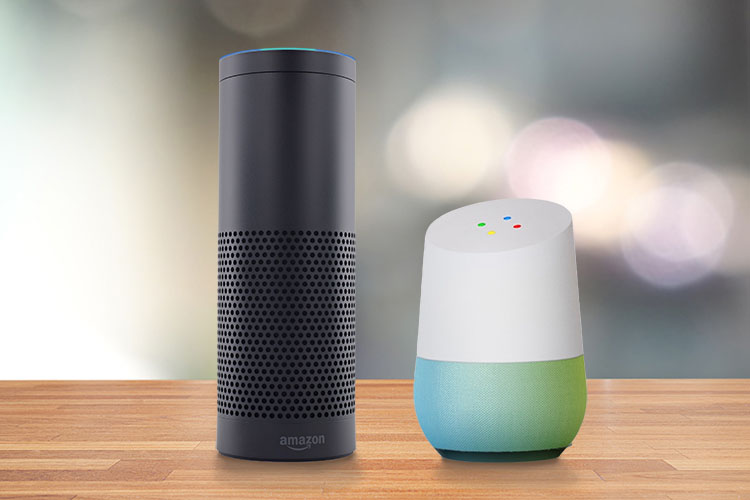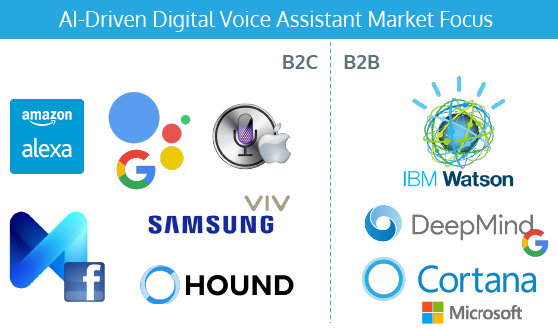Google Home Paves the Way for More B2C and B2B Adoption
 An Shortened Version of this article originally appeared in VentureBeat.
An Shortened Version of this article originally appeared in VentureBeat.
The recent Google Home launch has focused people’s attention once again on the consumer segment (B2C) of AI-driven voice assistants. Home represents the first able competitor to Amazon’s Echo and its Alexa voice assistant.
Because of all of the hype around Google, many people have overlooked a series of announcements from IBM, Microsoft, and DeepMind that were equally important from a business segment (B2B) perspective. IBM’s deals with Celgene, Pearson, and GM are significant B2B developments, as is DeepMind’s rapid expansion of its health care team and Microsoft’s Cognitive Toolkit release. These announcements only made a ripple in the tech and business media pond.
Amazon’s Alexa and Google Home are capturing an outsized portion of coverage because there are more outlets that cover, and hype, new consumer devices. Plus, it’s easy for people to try them out. There is no doubt that Google Home and Google Assistant on Pixel are important announcements. The B2C segment was becoming a one-horse race, with Apple falling behind and Amazon out in front. Google’s massive consumer reach will no doubt expand the product category.
However, the AI and voice assistant markets are becoming so large and generating so much investment that we need to start thinking about segmenting the leading companies in terms of their primary target customers. Each company appears to be falling naturally into a B2C or B2B focus.
Beyond Technology Taxonomies
Up to this point, discussions of AI segments have relied on technical distinctions. The most common contrast was between general AI and narrow AI. The former relates to the capability of artificial intelligence that can perform intellectual tasks previously considered the sole domain of human intelligence. By contrast, narrow AI can perform limited tasks within a narrow scope. There are further technical segments related to whether the communication function of the AI is machine-to-machine, based in natural language, communicates via text or voice-driven chatbots and more.
All of these distinctions are useful in the research lab. They focus on method and features as opposed to users and benefits. It is a supply-side versus a demand-side viewpoint. When you get into the real world of users and use cases, we need to think about it differently.
B2C vs. B2B Battle Lines
Today, this is a supplier-driven market. The developers of voice and AI technology are pushing adoption in these segments more than users are demanding it. It is much easier to educate users when you narrow the functional discussion to well-defined use cases that provide specific benefits. As a result, companies like Amazon emphasize consumers using Alexa in everyday settings, and IBM depicts business professionals using Watson to improve productivity and outcomes. These two companies have nearly zero overlap in use cases or in the minds of target customers. They have made their B2C and B2B choices clear. Using this simple lens, we can better understand the entire market and its current trajectory.

B2C: Amazon, Google, Apple, Facebook, Samsung, SoundHound
Amazon Alexa and Google Assistant are getting the most attention right now. Alexa is viewed as a leader because of its millions of Echo customers and Google because it has just launched Assistant on its new Pixel phone and Google Home devices. Google, of course, also has the benefit of potentially accessing over 1.4 billion Android users if they upgrade to newer versions of the OS. Benedict Evans from Andreessen Horowitz estimates there are about 900 million active iPhones and iPads with Siri, which originally introduced most people to this product category. We can refer to these three (Amazon, Google, and Apple) as the B2C incumbents.
That means services such as SoundHound’s Hound assistant, Samsung’s Viv (which is due out this spring with the Galaxy S8 launch), and Facebook M fall into the B2C challenger category. There are many more chatbot and text-based solutions, but this framework limits the analysis to solutions that have voice interaction because their sophistication is much greater and applications much broader. Hound and Viv certainly have this capability today, and Facebook claims it will have voice for M soon.
You can argue that Google Assistant has a B2B component because it can be enabled for Google Apps for work. However, a simple word density analysis of Google’s webpage dedicated to Assistant shows that consumer-oriented actions dominate the descriptions. Similar analyses show Siri, Hound, Viv, and Facebook all squarely focused on consumer applications for the time being.
B2B: IBM, DeepMind, Microsoft
On the B2B side, we have IBM, DeepMind (a Google acquisition run separately from the company’s other AI initiatives), and Microsoft clearly dedicated to solving business problems. IBM is the farthest along, with solutions for health care, insurance, financial services, law, education, supply chain, marketing, and HR.
DeepMind is best known for its conquering of games. The company recently demonstrated its acumen in the game Go and is now tackling Starcraft. While this many seem like a more consumer focus, it represents a similar path followed by Watson. That AI solution was taught initially by competing in chess and trivia games before turning its attention to business applications. The only two case studies listed on DeepMind’s website are health care and data center energy optimization — B2B all the way.
Microsoft is probably a more controversial inhabitant of the B2B segment. Most of the initial fanfare around Cortana focused on consumer applications similar to Alexa and Google Assistant and the recent Harman-Kardon intelligent speaker announcement is a clear B2C play. However, Microsoft doesn’t have the consumer reach of those competitors or Apple, so it has logically started to leverage its strength in general business applications to push the adoption of Cortana.
Surface and Windows 10 may have a role to play in exposing more consumers to Cortana, but the real consumer opportunity for the voice assistant is the nearly 50 million Xbox users. As Cortana services expand on Xbox, you could see Microsoft starting to become more competitive in the B2C segment, but today its strongest point of leverage is in B2B.
Blurred lines, then a sharpened focus
It is clear that AI and voice assistants have general purpose capabilities that can be utilized in either consumer or business settings. We should expect to see many of these services embedded over time in both consumer and business applications. In particular, Google Assistant, Amazon Alexa, and Microsoft Cortana seem destined to have some presence in both B2C and B2B segments.
However, the companies obviously realize that trying to go too broad right now means competing against everyone. Even companies of this scale can’t hope to knock out all of their competitors in the near term. That means more specialization before more generalization. Look for the B2C and B2B lines to sharpen before they blur again.
IBM Unveils Watson-Power Imaging Solutions for Healthcare Providers








